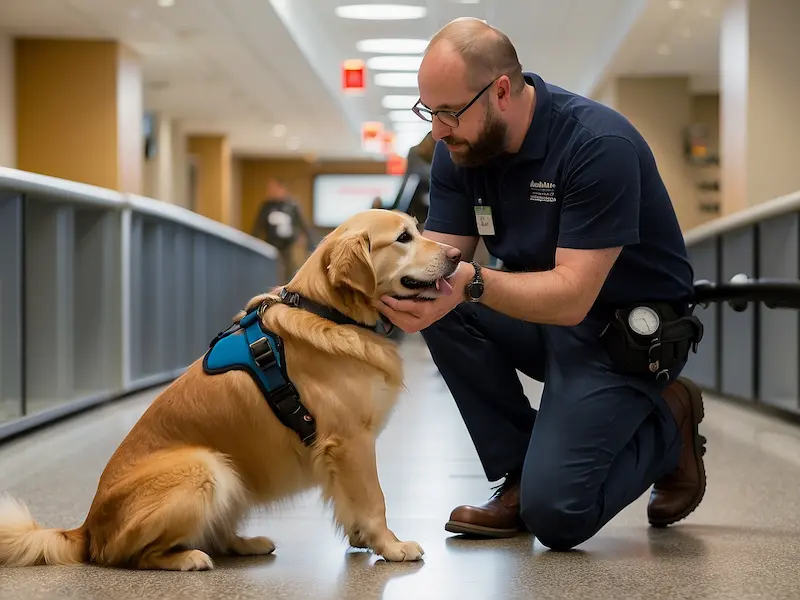Socialization training is a crucial aspect of preparing therapy dogs for their roles in public spaces. Therapy dogs provide comfort and emotional support to individuals in hospitals, schools, nursing homes, and disaster relief areas. To perform effectively, they must exhibit calm behavior, confidence, and responsiveness in various environments.
Proper socialization training ensures that therapy dogs remain well-mannered and adaptable, regardless of distractions or new surroundings. This guide explores key aspects of socialization training, including exposure techniques, behavioral conditioning, and common challenges encountered in public spaces.
Understanding Therapy Dog Socialization

What Is Socialization Training for Therapy Dogs?
Socialization training involves exposing therapy dogs to different environments, people, sounds, and situations to ensure they remain calm and composed. This training helps dogs develop:
- Confidence in new surroundings
- Non-reactivity to loud noises or unfamiliar objects
- Positive interactions with strangers, including children and elderly individuals
- Adaptability to various settings, from hospitals to busy city streets
Why Is Socialization Important?
Therapy dogs must be predictable and well-behaved in public spaces. Proper socialization:
- Reduces anxiety and fear-based reactions
- Prevents aggressive or overly excited behaviors
- Enhances the dog’s ability to focus on providing emotional support
- Ensures compliance with therapy dog certification requirements
Essential Socialization Training Steps
Early Exposure to Different Environments
Introducing therapy dogs to various settings from an early age helps them adapt smoothly to different scenarios. Key environments to include in training:
- Busy streets – Exposure to traffic, sirens, and crowds
- Hospitals and nursing homes – Acclimatization to medical equipment, wheelchairs, and hospital scents
- Schools and libraries – Interaction with children in a controlled setting
- Shopping centers and public parks – Exposure to different surfaces, people, and sounds
Interaction with Different People
Therapy dogs must be comfortable interacting with individuals of all ages and physical abilities. Training should involve:
- Meeting people using wheelchairs, walkers, or crutches
- Interacting with children, ensuring gentle and patient behavior
- Engaging with large groups without becoming overwhelmed
- Remaining calm when strangers initiate petting or interaction
Handling Unfamiliar Noises and Situations
Therapy dogs should be desensitized to common environmental noises and sudden movements. Exposure techniques include:
- Playing recordings of sirens, alarms, and loudspeakers
- Simulating unexpected movements (e.g., dropping objects, opening umbrellas)
- Encouraging calm responses through positive reinforcement
Leash Manners and Public Behavior
A therapy dog must walk politely on a leash and maintain composure in public spaces. Training should cover:
- Loose-leash walking – No pulling or lagging behind
- Ignoring distractions – Remaining focused on the handler
- Controlled greetings – Sitting calmly when approached
- Settling in place – Lying down quietly during long visits
Common Challenges in Socialization Training
Overstimulation and Excitability
Some dogs become overly excited or distracted in new environments. Solutions include:
- Gradual exposure to new situations
- Short training sessions with incremental increases in complexity
- Use of calming techniques, such as deep pressure therapy
Fear and Anxiety in Public Spaces
Fearful reactions can hinder a therapy dog’s effectiveness. Strategies to build confidence:
- Encouraging positive associations through treats and praise
- Allowing slow acclimatization without forcing interactions
- Practicing structured desensitization techniques
Managing Unpredictable Situations

Therapy dogs may encounter unexpected scenarios, such as aggressive animals or loud disruptions. Training for these situations includes:
- Teaching emergency cues (e.g., “leave it” or “focus”)
- Practicing controlled exits from overwhelming environments
- Reinforcing calm behavior through structured routines
Certification and Public Access Readiness
Therapy Dog Certification Requirements
While therapy dogs do not have the same legal protections as service dogs, they must meet specific behavioral and training standards. Certification organizations, such as Therapy Dogs International (TDI) and Alliance of Therapy Dogs (ATD), require:
- Passing a temperament test
- Demonstrating appropriate public behavior
- Completing supervised visits in therapy settings
Preparing for Evaluations and Public Visits
Before taking a therapy dog into public spaces, ensure they:
- Have mastered obedience commands
- Respond appropriately to distractions
- Exhibit controlled, friendly behavior in all situations
Conclusion
Socialization training is an essential component of preparing therapy dogs for their roles in public spaces. By gradually exposing them to different environments, people, and stimuli, handlers can ensure their dogs remain calm, confident, and well-behaved. Addressing challenges like excitability and fear will further strengthen a therapy dog’s ability to provide comfort and support effectively.
For those considering therapy dog certification, ongoing training and positive reinforcement will help maintain the dog’s readiness for public engagement. Properly socialized therapy dogs can make a profound impact, bringing comfort and joy to those in need.
Frequently Asked Questions (Q&A Section)
How long does socialization training take for therapy dogs?
Socialization training is an ongoing process, but foundational skills can be developed within 6–12 months, depending on the dog’s temperament and experience level.
Can older dogs undergo socialization training?
Yes, older dogs can still be socialized successfully, though they may require more time to adjust to new experiences.
What breeds are best suited for therapy work?
Breeds commonly used for therapy dog work include:
- Labrador Retrievers
- Golden Retrievers
- Cavalier King Charles Spaniels
- Standard Poodles
- Bernese Mountain Dogs
Do therapy dogs need special certification to enter public spaces?
Unlike service dogs, therapy dogs require certification for structured therapy work but do not have the same legal public access rights. Institutions may require proof of training and certification.
How can I help my therapy dog stay calm in busy environments?
Strategies include:
- Using positive reinforcement techniques
- Practicing gradual exposure to stimuli
- Providing breaks in quieter areas when needed
By following these training principles, therapy dogs can excel in public environments, bringing comfort and emotional support to those who need it most.

